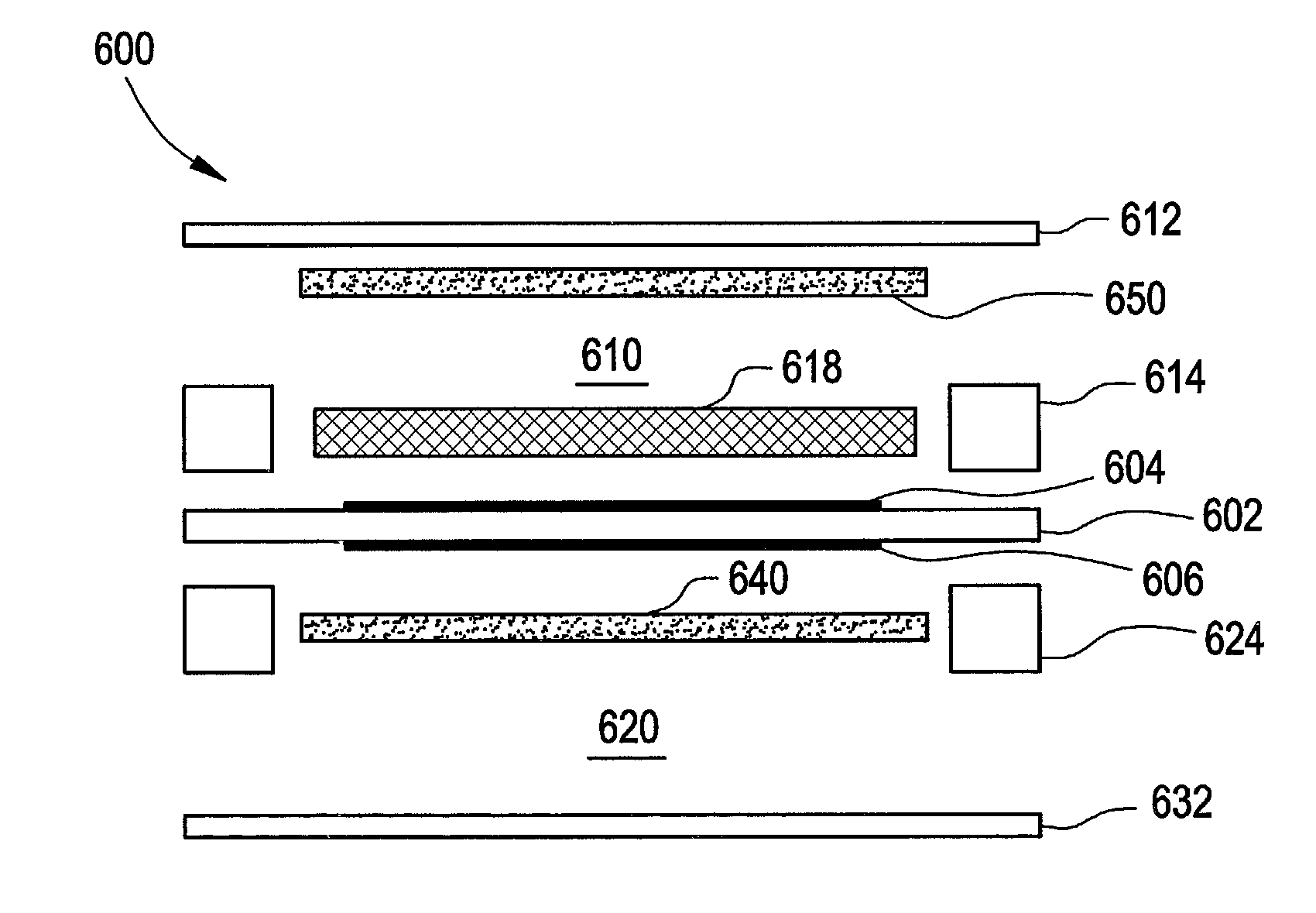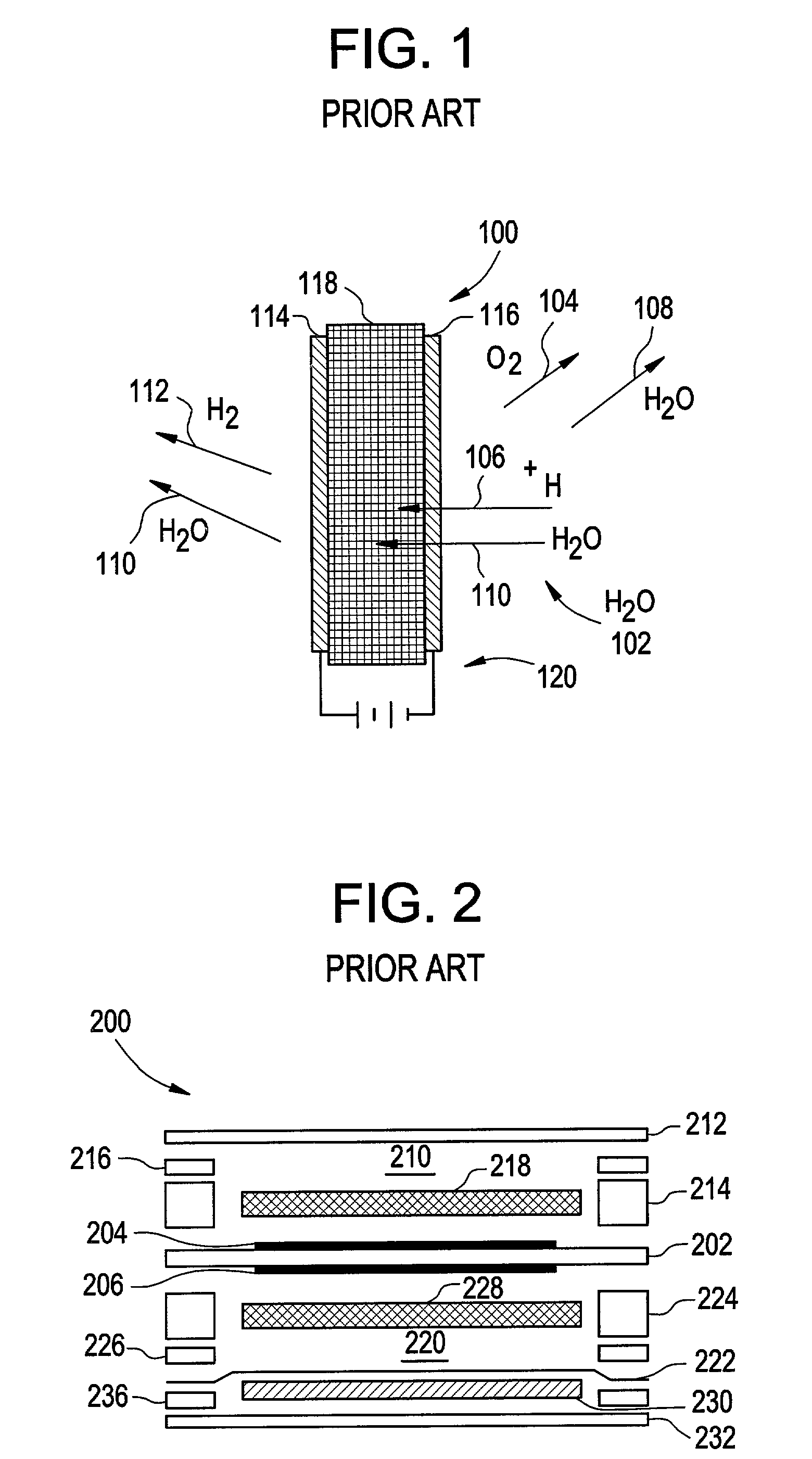Method and apparatus for maintaining compression of the active area in an electrochemical cell
- Summary
- Abstract
- Description
- Claims
- Application Information
AI Technical Summary
Benefits of technology
Problems solved by technology
Method used
Image
Examples
example 2
[0074] Pressure pad 340 is formed of a mixture of 50 wt. % VITON.RTM. and 50 wt. % niobium. The VITON.RTM. is in the form of cut up pieces of a 50 gauge cord having a diameter of about 0.125 inches (about 3.175 mm) and lengths of about 0.25 inches (about 6.35 mm)]. The niobium is in the form of cut up pieces having a minimum dimension of about 0.125 inches (about 3.175 mm) and a maximum dimension of about 0.25 inches (about 6.35 mm). The VITON.RTM. and niobium were mixed thoroughly and placed on a suitable sintering and pressing fixture having a diameter of about 1 inch (2.54 centimeters). The fixture was subjected to a pressure of 2000 psi and a temperature of 400.degree. F. The sintered plate comprises an integrated mixture of VITON.RTM. and niobium having a thickness of about 0.25 inches (about 6.35 mm), and suitable for use in a system having operating pressures between ambient pressure and up to about 10,000 psi.
example 3
[0075] Pressure pad 340 is formed of a mixture of 50 wt. % VITON.RTM. and 50 wt. % niobium. The VITON.RTM. is in the form of cut up pieces of a 50 gauge cord having a diameter of about 0.125 inches (about 3.175 mm) and lengths of about 0.25 inches (about 6.35 mm)]. The niobium is in the form of cut up pieces having a minimum dimension of about 0.125 inches (about 3.175 mm) and a maximum dimension of about 0.25 inches (about 6.35 mm). The VITON.RTM. and niobium were mixed thoroughly and placed on a suitable sintering and pressing fixture having a diameter of about 5 inches (12.7 centimeters). The fixture was subjected to a pressure of 2000 psi and a temperature of 400.degree. F. for 20 minutes wherein the temperature ramping was allowed to overshoot by 2.5.degree. F. for a period of 10 minutes. The sintered plate comprises an integrated mixture of VITON.RTM. and niobium having a thickness of about 0.2 5 inches (about 6.35 mm), and suitable for use in a system having operating pressur...
example 4
[0076] A number of unitary pressure pads were tested as follows: a silicone pressure pad comprising small carbon and nickel fibers (4.25 inch diameter, 0.33 inches (0.81 mm thick)) having a void volume of 48.2% was placed in a test device and subjected to a load of 35 inch-pounds, and a current of 25-2000 Amps was passed through the pad. Resistivity was calculated from the current and voltage. Results of the comparative tests are shown in FIG. 5. As can be seen from these results, elastomeric pressure pads comprising particulate Ag / Al, Ag / glass, Ag / Cu, Ag / Cu (3 hours at 150 amps), and Ni / C fillers (Tests 1, 3, 5, 5a, and 6, respectively) demonstrated low resistivities over a range of current densities from 25 to 175 Amps. Comparative test 2 is a pressure pad using niobium strips threaded through an elastomeric pressure pad. While this pad also has low resistivities, the niobium is not integral to the pad and the pad does not have a smooth surface.
[0077] The electrochemical cell desc...
PUM
| Property | Measurement | Unit |
|---|---|---|
| Fraction | aaaaa | aaaaa |
| Fraction | aaaaa | aaaaa |
| Fraction | aaaaa | aaaaa |
Abstract
Description
Claims
Application Information
 Login to View More
Login to View More - R&D
- Intellectual Property
- Life Sciences
- Materials
- Tech Scout
- Unparalleled Data Quality
- Higher Quality Content
- 60% Fewer Hallucinations
Browse by: Latest US Patents, China's latest patents, Technical Efficacy Thesaurus, Application Domain, Technology Topic, Popular Technical Reports.
© 2025 PatSnap. All rights reserved.Legal|Privacy policy|Modern Slavery Act Transparency Statement|Sitemap|About US| Contact US: help@patsnap.com



